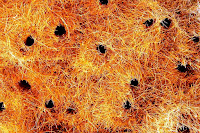
(Old "Windpompe", Kalahari Trails Nature Reserve, RSA)
We are ready at 6:15 AM for the guided walk with Prof. The decision to stay here and learn something about the Kalahari is wise: we have our own private Attenborough to guide us. Prof is another example of a woman living and working as a naturalist – more or less alone – in
(Professor Anne Rasa's cactus garden: one of the learning resources provided to guests at Kalahari Trails Nature Reserve)
Our walk on her reserve, which she is restoring to its original state, keeps us completely pre-occupied for three hours or so. Starting with the underlying geology of the region and the climatology, we move on the plants, insects and animals. Social spiders, robber flies, scorpions, ants, acacias and camelthorn trees and the ways in which they are all interwoven.
(Prof observes a raid by one species of ant on another species of ant, Kalahari Trails Nature Reserve)
It seems that the entire region has a clay “lens” that traps and holds a substantial amount of the scant annual rainfall. This substrate beneath the sand and the groundwater reservoir created there provide the Kalahari’s character and is a foundation for the unique and multiple adaptations found among the plants and animals.
We return for a huge breakfast with Renata, Prof’s assistant, who trained as an hotelier in her native
Learning to Look More Nicely
The San or the Bushmen as they are more commonly known are a source of great interest to all who visit the Kalahari. They compose about 40 percent of the population of my son’s village and therefore of the village school where he teaches in a distant district in
“So we paused at a set of four hoof prints and he turned and asked me ‘Now what happened here?’” Identifying the prints as those of a female springbok, Prof was able to see only that she had paused at that spot. Her teacher then said “Yes, but you must look more nicely.”
“Do you see how the front hoof prints are pressed more deeply in the sand in the front? This is where the mother called to her fauns”
Prof had taught us earlier that the mother springbok leave their young alone in the shade while they graze. If a predator approaches the only defense the fauns have is to be perfectly still. When the mother approaches she will call the fauns out from their cover and in doing so stretch their heads and necks forward, digging their front hooves down in a certain way.
“You must look more nicely” was the advice the tracker always provided. And now we have just lost him and all he knew about the desert. Dead with nine others in a drunken, head-on collision between two overloaded vehicles. “He came here before he set out and I warned him not to drive – and the driver of the other vehicle was drunk as well.”
The Prof is really growing on me: we drive off the neighbor’s herd of goats whose coughing spreads contagion to her antelopes; when I ask her about climate change in this region she scoffs and takes the position that in the long run the earth will return to a normal state (in the spirit of The World without Us). http://www.worldwithoutus.com/
This pupil of Konrad Lorenz is however saving her corner of the planet. We go on a night game drive with Renata.
(Beginning the game drive -- a red track on a restored section of the Reserve)
(Renata examines the carcass of a juvenile secretary bird -- specialized carrion beetles will devour the feathers while other beetles consume the soft parts of the corpse)
(An ostrich: the number are limited due a propensity to uproot the specialized vegetation, Kalahari Trails Nature Reserve)
(A large social weaver bird nest has partly fallen to the base of this acacia tree -- we have a chance to see it in detail)
(The social weaver nest looking up -- although the entrances are vertical, predatory snakes are still able to enter the individual nests by a special method of climbing)
(We examine the nest carefully to avoid snakebite -- more than 30 pairs of birds nest cooperatively in the massive structures)
The spot lights and the proximity of the game on the reserve are a lot of fun. We observe many that are nocturnal and many that are browsing much closer to the road than during the day.

(Sundowner: Will, Renata, and her mother share a laugh -- it seems that visiting your children in Africa is a shared custom)










